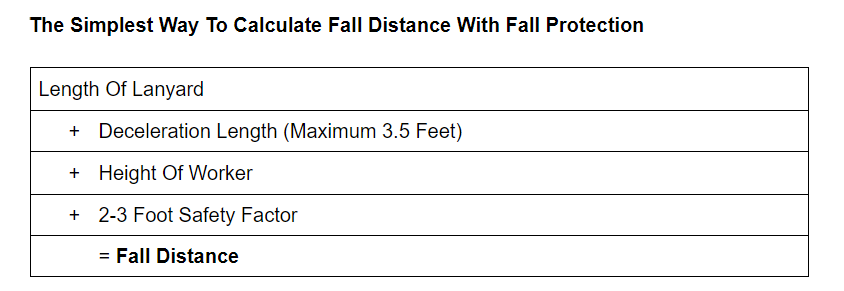When working with Fall Protection Equipment, there are a few different ways that you can calculate a Total Fall Distance.
You will need to know the Total Fall Distance on a job to meet OSHA’s standards for Fall Distance Clearance regarding a PFAS (Personal Fall Arrest System).
We are going to present you with two different ways to figure out a Total Fall Distance that will lead to similar results. Remember that you will need to determine the TFD before the decision is made that the PFAS is appropriate for the job.

The Total Fall Clearance Distance is the minimum distance required to ensure that if a worker was to fall that they would not make contact with the ground or next level beneath them. This number needs to be higher than the Total Fall Distance that a Personal Fall Arrest System will allow for the PFAS to pass.
The formula above is designed to Calculate the Total Fall Distance that a PFAS will allow.
Deceleration Length:
The Deceleration Length, or Deceleration Distance is the length that a lanyard will stretch in a fall arrest scenario. OSHA dictates that Deceleration Distance must be 3.5 feet or less.
Height Of Worker:
This formula requires that you know the height of the worker. This is fairly self explanatory. It should be noted that this formula may be slightly less precise than the alternate formula that we will present to you next.
Safety Factor:
The “Safety Factor” is the distance from the worker’s feet to the ground or lower level. OSHA’s guidelines say that this should be at least 2 feet, but industry standards are often calling for at least 3 feet these days.

Note: To See A Diagram On This Method From OSHA, Click Here
The above formula is specifically designed to account for a set up where the connecting D - Ring Carabiner on a harness is located below the anchor being used.
This may require some extra measurements but can potentially give a more precise measurement.
Harness Stretch Length:
The D - Ring Shift is the distance a D-Ring will move in the event of a fall. Most industry standards approximate this at 1 foot, but it can sometimes vary. This information can often be found in a Manufacturer’s Manual.
The D - Ring Shift is added to the Back D - Ring Height to determine the overall Harness Stretch. The Back D - Ring Height is measured from the D - Ring to the sole of the worker’s shoe or boot.
It should be noted that most harnesses are standardized for people between 5 and 6 feet tall. A D - Ring will often need to be adjusted for a worker who is more than 6 feet tall.
Closing Thoughts
This guide is designed to simplify two of the most common ways to calculate a Total Fall Distance for your Personal Fall Arrest System. Hopefully, it was helpful and will make figuring out these calculations a little easier.
Remember, to always research OSHA and ASME standards, and be sure to make sure all Fall Protection Gear is compatible with these requirements.


